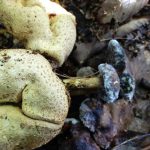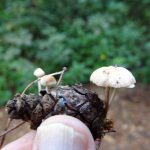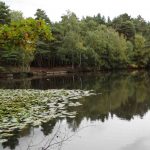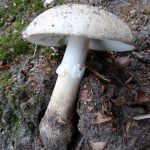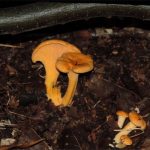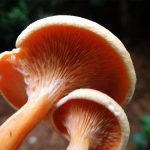Mike Waterman led a fungus identification walk at the National Trust’s Simon’s Wood near Finchampstead on Saturday 15th October. The woodland has tall Scots Pines, with birch, oak, Sweet Chestnut and a few Beech trees. A number of different fungi were found close to the car park, including Brown Rollrim Paxillus involutus, Deceiver Laccaria laccata, Bay Bolete Boletus badius and Amethyst Deceiver Laccaria amethystina. Several specimens of the Parasitic Bolete Pseudoboletus parasiticus were growing on a somewhat-deflated Common Earthball Scleroderma citrinum. A few of the braver members of the group tried testing small fragments of the bright red Beechwood Sickener Russula nobilis for hotness. Later in the walk, the paler pink Birch Brittlegill Russula betularum was found growing under birch. Its cap peeled easily. A large specimen of Beefsteak Fungus Fistulina hepatica was growing on the trunk of a Sweet Chestnut. Rarest find of the day was probably the Conifercone Cap Baeospora myosura which was growing on a pine cone. On the eastern side of the wood, a fallen log was covered with yellow Sulphur Tuft fungi, while several clumps of Fly Agaric Amanita muscaria added a splash of scarlet to the woodland floor. Mike cut open a brown Bolete with a pale black-speckled stem. After several minutes, when it had not changed colour, he was able to confirm that it was Brown Birch Bolete Leccinum scabrum.
The walk continued round the lake. Coal Tits were calling from the trees nearby. A specimen of the pale yellow False Deathcap Amanita citrina was examined. The base of the stem was growing out of a cup-like volva and it had a prominent ring on the stem. A whitish fungus with a mealy smell was identified as The Miller Clitopilus prunulus. Two different kinds of Milk-cap were found – Woolly Milkcap Lactarius torminosus and Oakbug Milkcap L. quietus. Small drops of white fluid appeared when their gills were cut. The route crossed a more open, heathy area, where another member of the Amanita family, A. excelsa var. spissa, was found. Towards the end of the walk, a number of specimens of Chanterelle Cantharellus cibarius were found. Their thick, disorderly gills were compared with the forked gills of the False Chanterelle Hygrophoropsis aurantiaca, which had been seen in some numbers earlier in the walk.
Pictures by Rob Stallard and Laurie Haseler
| Species | English name |
| Paxillus involutus | Brown Rollrim |
| Scleroderma citrinum | Common Earthball |
| Laccaria laccata | Deceiver |
| Russula ochroleuca | Common Yellow Russula |
| Boletus badius | Bay Bolete |
| Gymnopus erythropus | Redleg Toughshank |
| Pseudoboletus parasiticus | Parasitic Bolete |
| Gymnopilus penetrans | Common Rustgill |
| Mycena galopus var. galopus | Milking Bonnet |
| Laccaria amethystina | Amethyst Deceiver |
| Russula atropurpurea | Purple Brittlegill |
| Piptoporus betulinus | Birch Polypore |
| Rhodocollybia maculata | Spotted Toughshank |
| Trametes versicolor | Turkeytail |
| Fistulina hepatica | Beefsteak Fungus |
| Boletus cisalpinus | |
| Baeospora myosura | Conifercone Cap |
| Hygrophoropsis aurantiaca | False Chanterelle |
| Gymnopus dryophilus | Russet Toughshank |
| Russula nobilis | Beechwood Sickener |
| Russula fellea | Geranium Brittlegill |
| Biscogniauxia nummularia | Beech Tarcrust |
| Postia subcaesia | Blueing Bracket |
| Hypholoma fasciculare var. fasciculare | Sulphur Tuft |
| Hebeloma crustuliniforme | Poison Pie |
| Russula velenovskyi | Coral Brittlegill |
| Tricholoma fulvum | Birch Knight |
| Amanita muscaria var. muscaria | Fly Agaric |
| Lactarius tabidus | Birch Milkcap |
| Leccinum scabrum | Brown Birch Bolete |
| Amanita citrina var. citrina | False Deathcap |
| Coprinellus micaceus | Glistening Inkcap |
| Clitopilus prunulus | The Miller |
| Lactarius torminosus | Woolly Milkcap |
| Russula nigricans | Blackening Brittlegill |
| Lactarius quietus | Oakbug Milkcap |
| Amanita excelsa var. spissa | |
| Russula betularum | Birch Brittlegill |
| Amanita fulva | Tawny Grisette |
| Cantharellus cibarius | Chanterelle |
| Panellus stipticus | Bitter Oysterling |
List by Mike Waterman

